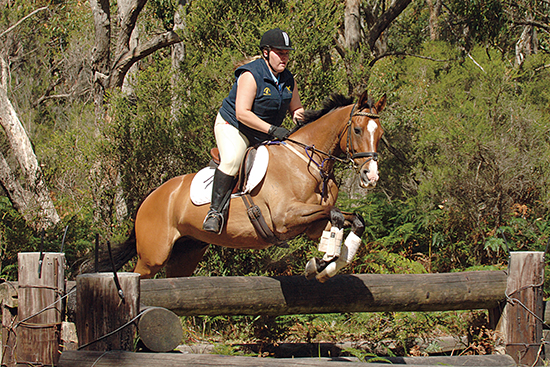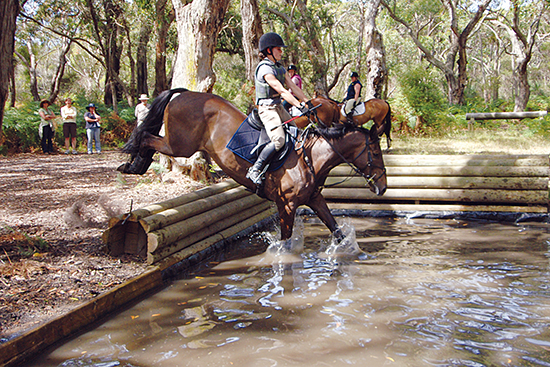Story by Chris Hector, Photos by Roz Neave
What could be nicer? A perfect setting, some talented horses and riders, a respectable cross country course, a cool sunny day, and Gill Rolton is in full swing, doing what she loves, teaching…
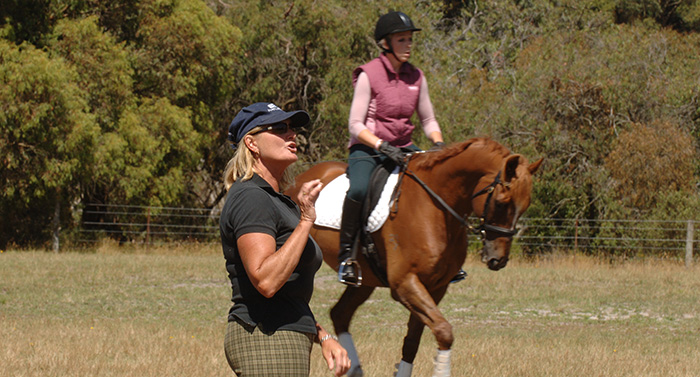
The venue is the Main Ridge Pony Club on Victoria’s Mornington Peninsula. It all started out when Gill donated a day’s teaching to an auction to raise money for the Victorian Olympic Council, and was ‘bought’ by the Pony Club… And from then on it just ‘growed’ until Gill ended teaching for seven solid days.
What does the outside rein do?
She asks her pupils.
“Keeps the horse straight…”
“Yes, it controls the outside shoulder, it helps in the halts, it must always be a connecting feel, if the connection is too strong it blocks the inside hind leg. The contact must be elastic in both reins.”
And so it goes. What is the function of the outside leg? The inside leg? The inside rein?
Gill is one eventing instructor who takes her dressage seriously, spending time last year in Germany with the top instructor, Jean Bemelmans. Gill is well aware that international eventing competition has moved to another level in the first phase, and that if Australia is to regain its eventing crown it is going to take some serious work on the flat to get there…
I guess there will be nothing new in the dressage work for readers of this magazine. It is straight out of the textbook but sensitively applied to these predominately Thoroughbred horses.
“We want connection not collection, elastic contact, activity behind, now let them chew the bit out of your hand, stretching down. If the horse won’t stretch, ask for a tiny counter flexion, just a few seconds, then give back, with your legs pushing the horse’s neck down, keep that light elastic contact, feel the hind legs stepping through. Now give away the outside rein – HORROR, give AWAY the outside rein? Yes, you can check that your inside leg is holding him out. Now give away the inside rein, check that you have him on the outside rein and that the connection is still elastic.”
“Don’t be afraid of letting the horse go down deep in front. There are riders who are scared they will not get their horse back up again – it is really no problem to ride the horse back up again.”
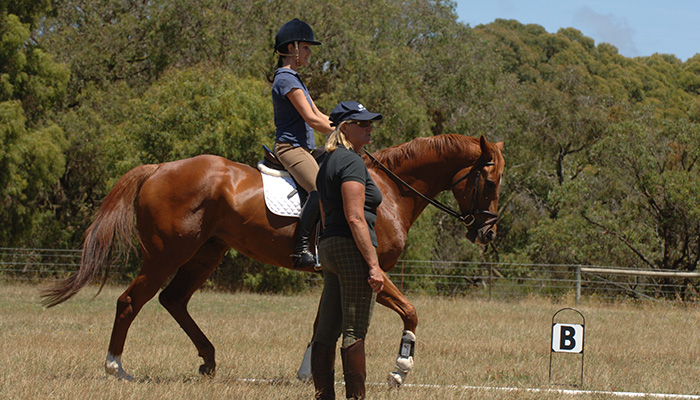
Erin Callahan and the 7yo Accomplice. The chestnut gelding is bred to event, being by Brilliant Invader, and out of Connectic Kate, who was the dam of Warren Lampard’s advanced eventer Bootlegger. Twenty-four year old Erin is a dentist, and has been working with Accomplice over the past 12 months, with three starts in Preliminary…
It would seem that Gill is even trying to get rid of that dreaded eventer’s elbow: “Think of your elbows as hinges, bent, hands level and together. Sit square and even in the saddle. Open your knees, open your thigh, let the weight go to your heels, keep your knee soft…”
Gill then starts on an interesting exercise, getting her riders to make trot to walk transitions, and back to trot, making the time in walk shorter and shorter until the riders just start the downward transition then ride on without going to walk.
“Keep the hands soft, shorter and shorter then out, so the hind leg comes under and pushes off, and lightens the forehand. Close up without pulling and GO!”
next we move to jumping
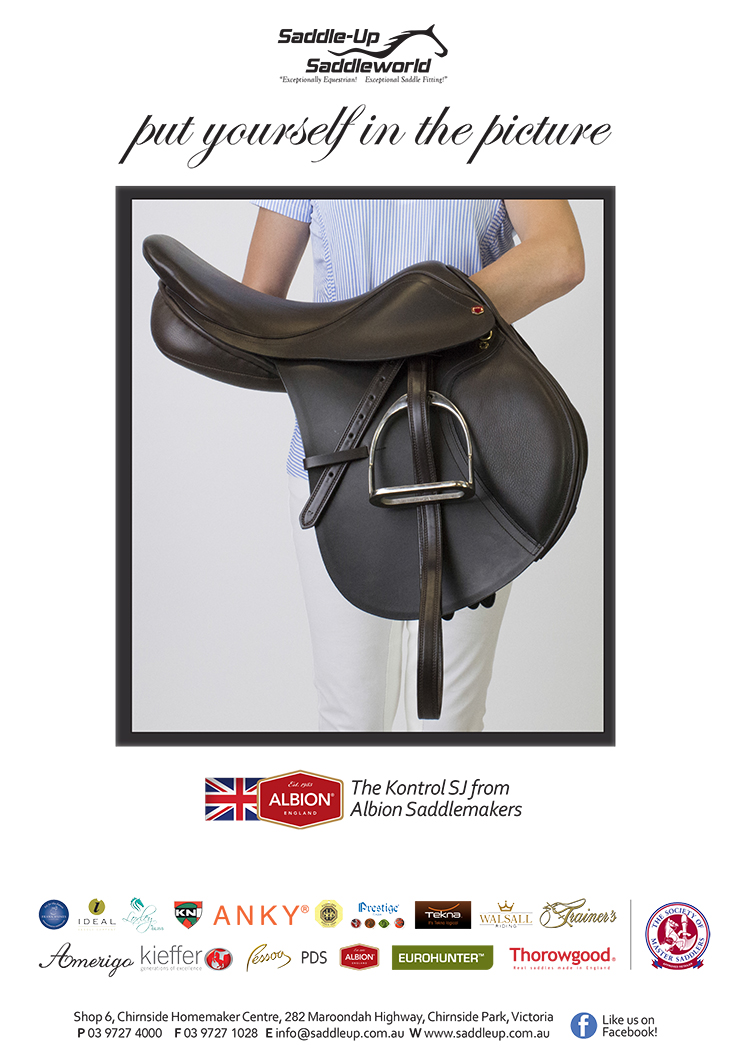
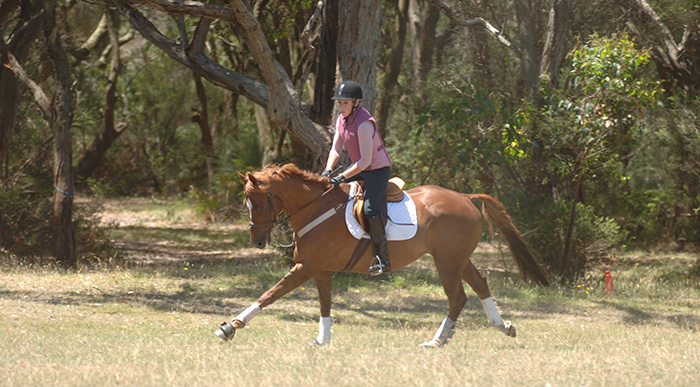
Warming up the jump – twenty-year-old Nadine Rotherham with her 8yo TS Swampfox. Nadine has had the horse for two and a half years and is competing Grade 1, Pre-Novice.
It’s sweet work and all the horses improve, get softer, stretchier and start to move. Time for a delicious lunch under the trees with Main Ridge members before setting off to tackle the cross-country track.
But before they hit the track, Gill wants to see them over a few little cross rails…
“We’d already done a warm up in walk, trot and canter, and made sure they were loose and forward, and on the aids – going forward, coming back. Before they go cross-country I like to see them jump a fence. I hadn’t seen any of these horses jump before, so I want to see them over a few cross rails and showjumps before we go over the solid stuff. I like to get them up in the air to see how they actually jump. Trot in, over a cross rail, then canter down in an even five strides to another cross, and then gradually build that exercise up into a bigger fence. It’s just an exercise to work on straightness and line, rhythm and balance – and you can also work on the rider’s position, make sure they ride to where they are looking, and you can also look at the horse’s technique.”
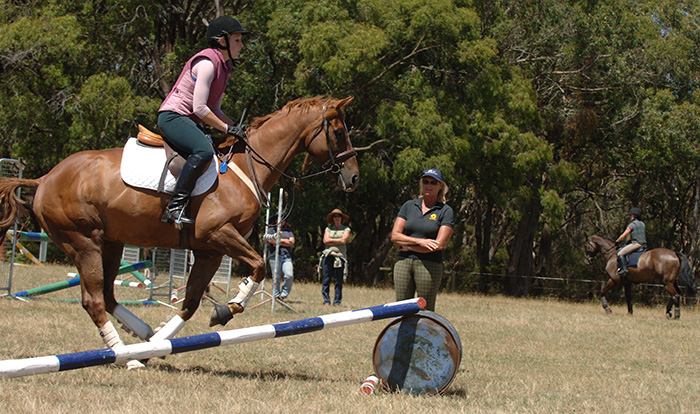
The skinny is all the go with course builders, so it was no surprise when Gill had her crew jumping a 44-gallon drum…
“These days the course designers are getting trickier and trickier with narrows and the horses have to be schooled to recognize a narrow and draw to the fence. Horses are so used to jumping coloured fences and poles but they are not so used to jumping a solid narrow obstacle with poles on either side of it – they have to learn to draw into that narrow and jump it. These days you find course designers doing more little stumps, little round tables, all sorts of things, which are quite different, and you need to give the horse a feel for them. Until the horse learns not to get too deep, and the riders get a feel for riding their line and keeping their eye up, they are going to be in trouble. So you work on that over something that is not fixed, something you can pull apart and put back together again, before you try it on those solid cross country fences.”
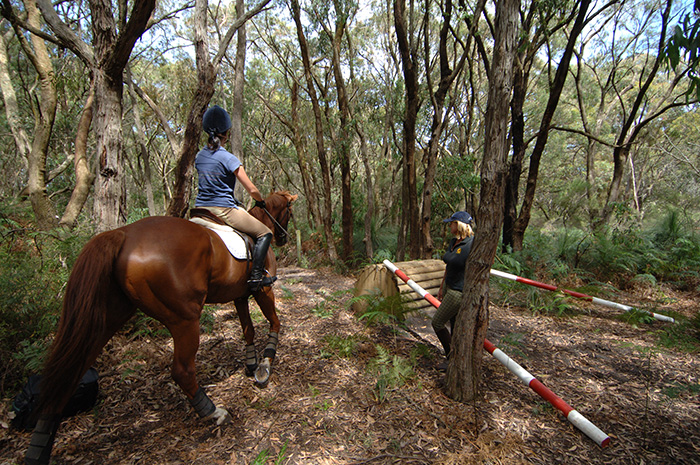
First get him used to the drop – then try the fence. Accomplice learns about Sunken Roads…
Gill is so fanatical about never letting a horse go around a fence, that she has her own ‘skinnies’ made portable, so after they have been jumped they can be removed from the working arena, and no one gets the idea they pass them by…
Out to the bush and the first challenge was a pretty straightforward post and rails…
“The fence is in shadows though, the whole cross country track tends to be shadowed, so we need to get the horse’s eye on the fences in the shadows, it’s funny lighting.”
“The task for the horse and rider is to pick a nice spot and just keep on coming to that single fence. We are working over a little vertical, then a bigger vertical on five or six strides depending how you ride it, but on a funny line in with a big grass tree in the way so you had to make a decision: left or right. It was better to come in on the left hand side. You had to actually jump slightly across the front of the fence to jump out and get a curving line back in the six, or if you could pick a line that was a little more direct you could get there in five.”
“Next to that was the Grade 1 fence – a bit taller post and rails, still on the left hand side of our grass tree, on more of a curving left line to the first part. When you jumped that it was quite a forward two strides, a regulation two strides but because you are coming off a turn, it meant that you had to really ride to make to two strides. Then it was a matter of sit up and keep the horse in balance because it was a waiting four strides down to the next one. If you had a forward enough canter and a big enough jump over the second one, then you could keep on coming down in three but certainly in training, that was not the thing to do, much better to sit up and wait for the four.”
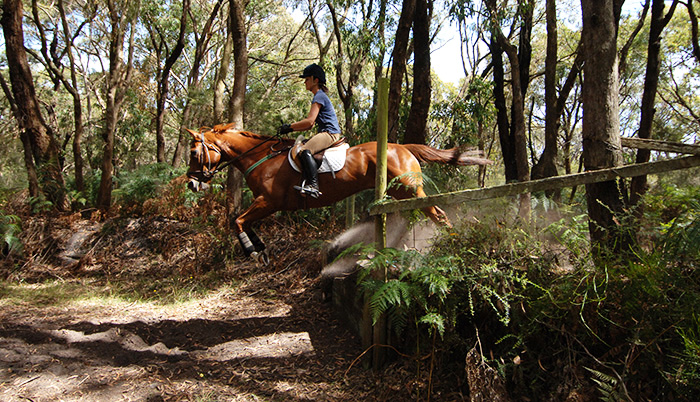
It was round the corner and through the bush to one of the more interesting fences on this Ewan Kellett re-vamped course, a Sunken Road with a skinny coming in.
“The Sunken Road was quite spooky because once again the shadows and the light played a part. You are coming down a track where it is difficult once again to get a line on it, to a narrow roll-top, to quite a short one stride down into a two stride sunken road. If you walked from the base of your roll top to the edge of the drop down, it was about 15 feet, so it was very short. But when you looked at the middle of the rolltop to the edge, it was about 18/19 feet which is actually quite a reasonable one stride distance, given once again that you are coming down a track without a particularly good line onto it.”
“Because we had a couple of younger horses that hadn’t done anything like that before, we popped up the out of the Sunken Road, then we popped inside the roll-top and down the step and two strides and out…”
“The nice little chestnut horse (Erin’s Accomplice) was really quite careful. He didn’t know what to do with his front legs, so we took time to get him confident going down the step. I spoke to the riders about how to use their body going down a drop, how to keep the horse in balance going through a fence like that and the importance of keeping your eye up and on your line, so that you can ride the line forward and straight and in balance, and give the horse every opportunity to do it well.”
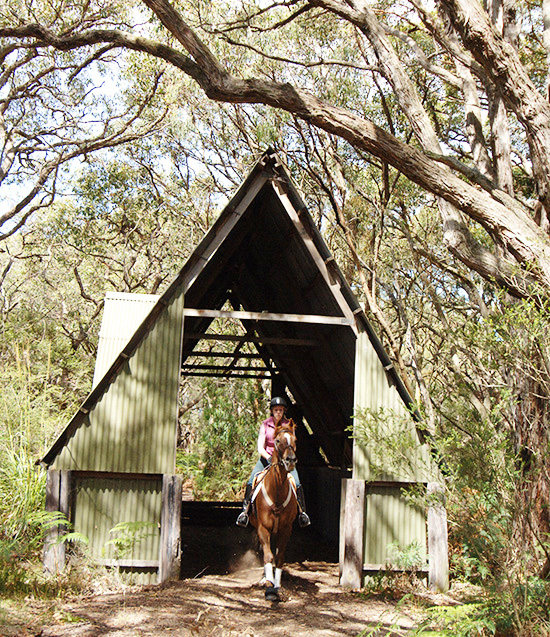
Then we encountered something that an Australian version of the House on the course at Saumur, except in the French version there is water inside the house, whereas the Main Ridge version, it was just a ride through…
“Basically in the shed it was a very long one stride, or a very short two if you had rails in and rails out. So we opted for no rails out, and a smallish jump in, just to give them the feeling of jumping into an enclosed space. You were going from light into dark, and once again, the sort of exercise horses need to do and become confident with. Compared with Saumur, where they have a big shed and jump into water, this was much softer, but still a good version of a jump into darkness.”
It was down the windy sandy track to a Hexagon, offering multiple options…
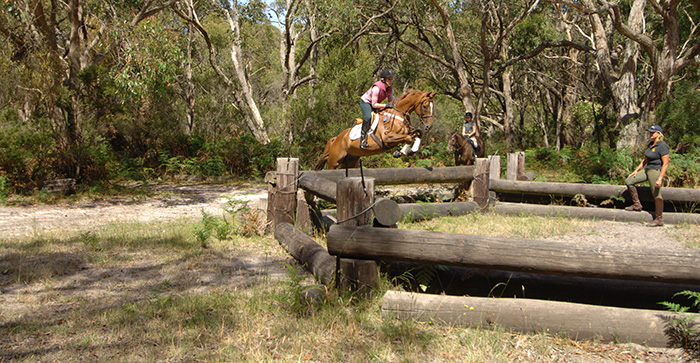
“We had a good big calf shelter first, then seven forward or a more waiting eight strides to a post and rails, a forward one stride to a vertical and another forward one stride oxer out. The calf shelter got them going forward, you could jump that and keep riding. For those who could keep riding through the line, it rode beautifully. Anyone who hesitated coming into the vertical found the distance very long – which is going to be your problem there. Our nice little chestnut did chip an extra on in there but Erin did a great job of keeping her focus, keeping her eye up, keeping her leg on – the horse just put in its little short one and she kicked on out. It was one of those you have to pick up on a forward stride because of the distance.”
Nicole Wernke is twenty-one and her gelding, Connection is 13 years old. Nicole has been riding him for four years and recently won the Preliminary at Camperdown.
And the experience of the mega talented ‘baby’ chestnut raised the question of the delicate line between giving the horse the experience it needs while at the same time, not frying its brain…
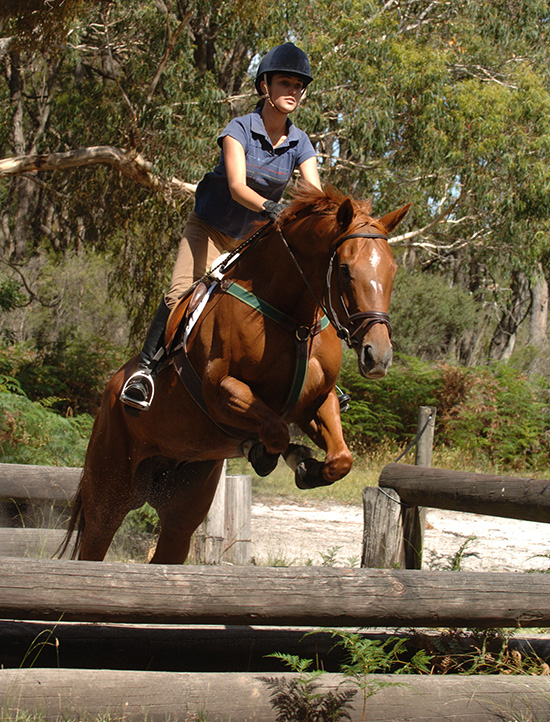
“Absolutely, that’s why I took so long on the Sunken Road, to get the horse confident going down the drop before we approached the narrow, and she did that super. By the time we got to the Hexagon, I think he was getting tired. On reflection, maybe I could have said, don’t bother jumping this line. But he was jumping so well and so confidently. It was just his inexperience, he was looky and Erin wasn’t quite quick enough on the landing to get her leg on and keep him coming, that’s when he put in the chip. So yes it is a fine line…”
Catherine Tolliday with Parkview Make Believe, and eleven year old by the Warmblood stallion, Close Encounters. Seventeen-year-old Catherine has been competing in Pre-Novice eventing and showjumping with the dark brown gelding.
Is that a case of ‘kids don’t try this at home’ – do you go to an instructor to learn these things?
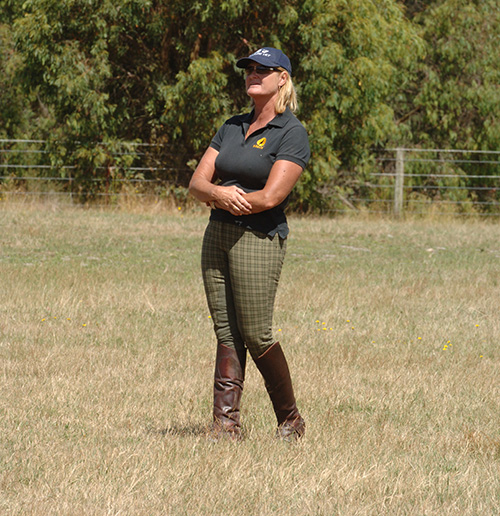
“Very important to have someone with you who knows what they are doing because if you are not sure of the distance yourself, or you are not sure of the way the horse is jumping, then over solid, fixed fences, it can be quite dangerous. It is always best to have an instructor with you – and then obviously if things do go wrong, there is someone to help re-build confidence.”
On to the final fence, some fairly friendly water…
“The water was friendly but it always causes a lot of problems at the competition they have here, because it is a little black square and you are coming off turns on tracks where they don’t see the water until the last minute. Often the riders come in way too fast and the horses are frightened by their reflection in this black hole, and they stop, or they have problems. It is the sort of fence that you need to work them up to. That’s what we did, put the horses in the water, schooled through the water, getting them walking and trotting and confident before we put them through the lines. One line was just a barrel on a curving two stride to get on to the drop into the water. The main line, the Grade 1 line, was a Trakehner, six or seven strides into a bigger roll top into water, two strides in the water, then out and a waiting three to another narrow roll top. It was good, the horses and riders all coped very well.”
Do you enjoy teaching?
“I love teaching anyone who wants to learn. I don’t mind who I teach as long as they are enthusiastic…”
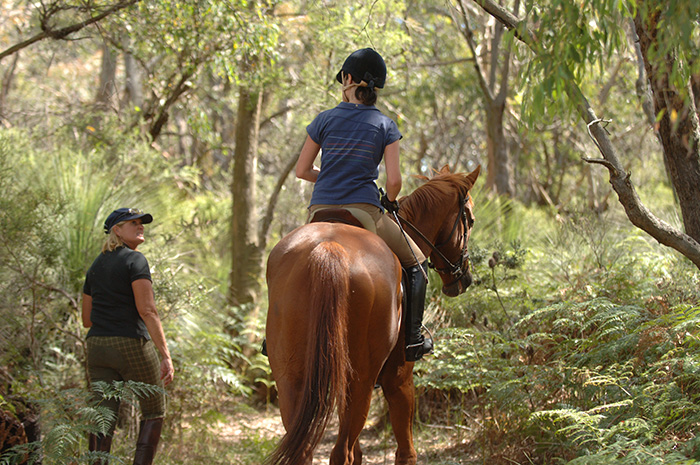
This article first appeared in THM April 2006.




